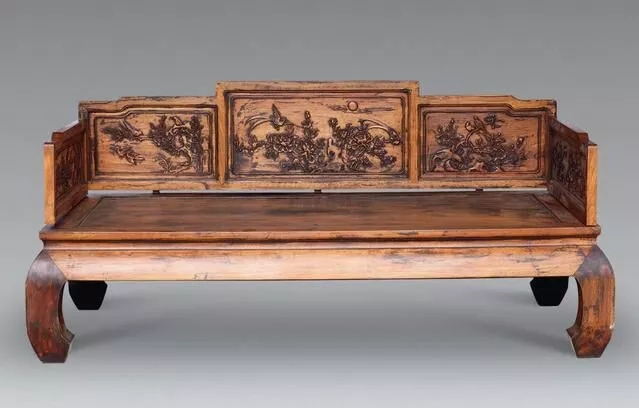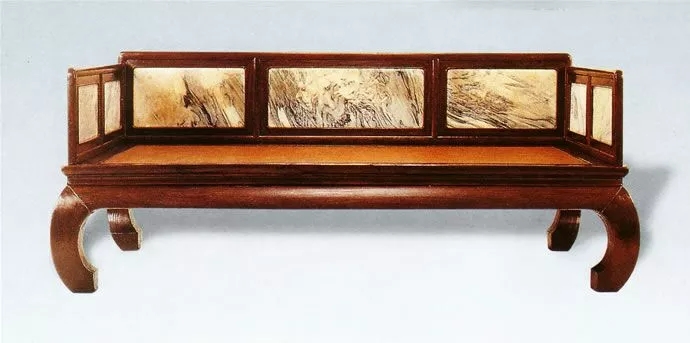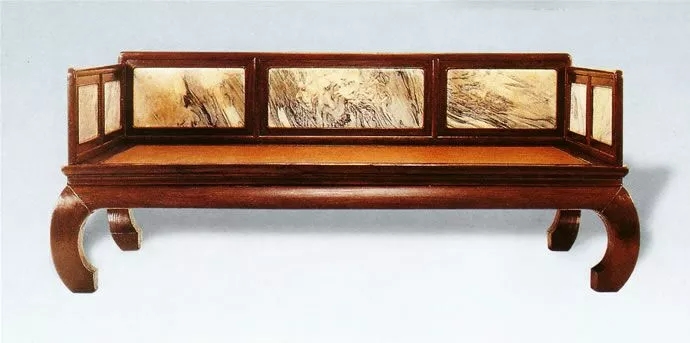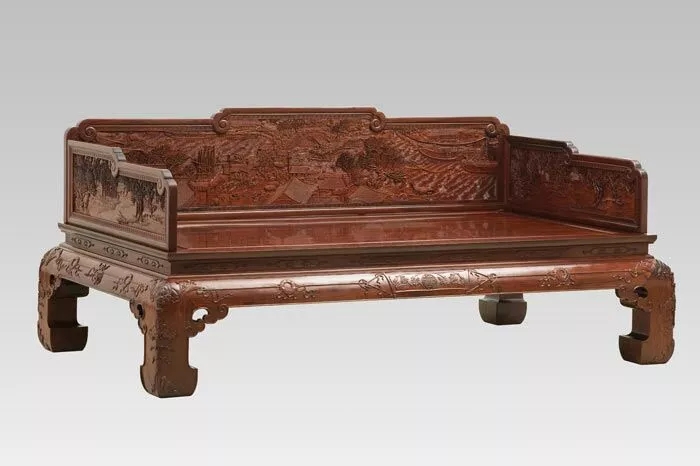
China has a profound etiquette culture. As the highest level of hospitality in ancient times, the Luohan bed is even more culturally profound. So, what is an Arhat bed? What is the origin of the Luohan bed? Why is Luohan Bed called Luohan Bed? What are the sizes of Luohan beds? and many more. Today, Zhimu talks about the opening of the first chapter, and the editor will give you a detailed explanation of the past and present of the Luohan bed.
What is Luohan Bed?
The Arhat bed and Maitreya couch are generally larger in size, and there are two types of waistless and waisted. Those with a waistband, a wider central part of the teeth, and a larger curve arc are commonly called "Arhat Belly", so they are also called "Arhat Bed". Luohan beds have always been popular and practical furniture.

The origin of the Luohan bed
The living custom of the ancients before the Sui and Tang Dynasties was to sit on the ground. Although it evolved into sitting on the ground after the Song Dynasty, the habit of sitting cross-legged has been retained. Maitreya couch and Luohan bed are all kinds of furniture reserved to adapt to the old customs of the Chinese people.
According to legend, the Luohan bed was first used by monks for sitting meditation, and after continuous changes, it was widely used in the Ming and Qing Dynasties. It can be seen that the origin of Luohan Bed is relatively noble. The Luohan bed is different from the general seat. It can be used not only as a chair but also as a single bed. There is a small table on the top and a bed on the bottom. The bed is surrounded on three sides. People sitting on it are quite distinguished. It is one of the highest level of hospitality.
There is no convincing explanation for the origin and common name of the Luohan bed.
Argument 1: Regarding the origin of the Arhat bed, a speculation is related to what the Ming people call Maitreya couch.
Argument 2: The Luohan bed is an evolution of the original Han couch (the seat of the Han Dynasty). The "Arhat Bed" was the predecessor of the "Throne" of the Ming and Qing courts. It was a small couch, like a modern "sofa". There are two types of sleep in ancient China: big sleep and nap. Big sleep is the formal sleep at night. Nap refers to naps such as lunch break. Couch and Arhat bed are used for naps and can be used to entertain guests, while canopy beds and babu beds are used for big sleeps. , Can’t be used for hospitality.
The third argument: In the early days, Arhat beds were mostly high-level people in temples, such as abbots and abbots. They meditated on them during the day and slept on them at night. The average monk sleeps in a bunk, and there will not be an Arhat bed in their room. Only the great monk with status can sleep in the bed. The great monk calls it "Arhat", so it is called the Arhat bed.
Statement 4: The origin of the Luohan bed, there is another theory, which is based on the leg and foot structure of the Luohan bed. Because the legs of the Arhat bed are curved outwards and have a larger arc, it is very similar to the big-bellied Arhat in the temple, so it is commonly called "Arhat Bed".

The origin of the Arhat bed
There are four types of bedding in ancient Chinese furniture, namely couch, Arhat bed, canopy bed, and Babu bed. The latter two are only used as bedding for sleep; while the first two have the function of sitting in addition to sleep. In ancient China, there were two types of sleep: big sleep and nap. Big sleep means formal sleep at night. Nap refers to a nap such as a lunch break. Couches and Arhat beds are used for naps and can be used to entertain guests, while canopy beds and babu beds are used for big sleeps. , Can’t be used for hospitality.
We know that before the Han Dynasty, the Chinese people's living style was to sit on the floor, so the center of life must be around the sleeping place, and the guests are all around the owner's sleeping room. Over time, a hierarchical view of Chinese people's hospitality has been formed. Before the Qing Dynasty, and even in the early years of the Republic of China, the highest level of Chinese hospitality was always on the bed or on the kang. The main function of the couch and the Luohan bed is instead of sleeping, but hospitality.
Since the "Han Xizai Night Banquet" from the Tang Dynasty to the Five Dynasties, you can frequently see the ancient people's hospitality scenes centered on the couch or the Arhat bed by browsing the paintings of the past dynasties. Since the Ming Dynasty, especially in the Qing Dynasty, this kind of etiquette has become established. Therefore, the Luohan bed has developed from simplicity to gorgeous, and gradually emphasizes its own decoration. The three-screen Luohan bed is an example. This entertainment was originally in the collection of the Chinese Classical Furniture Museum in the United States. It has a three-screen style, with seven black and white marbles in the frame. The front wall is slightly higher. The Qing style features of this bed are obvious, but the basic features of the Ming style are still retained. For example, although the front wall is filled with three pieces of marble, it can still be in a long and flat style, which is different from the Qing style, which is high in the middle and two ends. The front wall is only slightly higher than the two sides. Very common during surgery.
On the other hand, the Qing-style Arhat bed often presents a mountain-shaped enclosure on the front, and steps are also commonly used on both sides, forming a certain gap. This requires the front wall, especially the middle piece to be tall, to keep the wall from falling too short after several passes. In the Qing Dynasty, the number of five-screen, seven-screen, and even nine-screens also appeared on Arhat beds in the Qing Dynasty. This forced the front wall to be raised to an embarrassing situation. In this way of thinking, the shorter the luohan bed, the older the age.

The distinction of Luohan bed
There are many differences in the making of Luohan beds in the Ming and Qing Dynasties. Firstly, the use of marble for the furniture is not seen in the furniture of the Ming Dynasty, and the second is that the form of stone installation is also very different from the construction method of the Qing Dynasty. Craftsmen in the Qing Dynasty often clamped the marble with a core board first, and then installed it into the frame. Ming-style workmanship often installed the stone directly into the frame. Sometimes due to the uneven slate, the frame was notched and curved. Generally earlier.
The legs of the Luohan bed have a large degree of curvature and twisting power, commonly known as "legs of sweet cane". It can also be distinguished from the leg of the bed. The difference between the Qing style drum leg Pengya and the Ming style large excavation workmanship is entirely in the understanding of the Luohan bed legs, is it powerful and implicit, or powerful and exaggerated? In general, the Ming-style Luohan bed has no legs and feet, which gives people strength but is very subtle. The Qing-style Luohan bed's similar legs and feet are more lively in strength and appear to be exaggerated.

Arhat bed size
The size of Luohan bed is divided into different sizes, and the commonly used sizes are mainly as follows:
The general Luohan bed size is 210X90X48CM;
The size of the Arhat bed for large smoking cigarettes is generally 220X125X50CM;
The size of modern antique mahogany Arhat bed is more flexible and comfortable, the main sizes are: 100X200X45CM, 120X200X46CM, 90X200X45CM

Arhat bed placement and its function
In terms of the size of the Luohan bed, the Luohan bed is a larger seat. Arhat beds are also very delicate, usually placed in the middle of the Arhat beds, with cushions on both sides, elegant and solemn. The Luohan bed is more casual in use, either outdoors or indoors. The fixed position of the Luohan bed is mainly the living room, study and boudoir.
Because the Luohan bed has the dual functions of a bed and a seat, the Luohan bed can be placed in the bedroom. You can sit on it with two people, play chess and talk, or lie down alone and enjoy relaxing time; It is also a good choice to put the Luohan bed in the living room. The Luohan bed can also be in harmony with the modern style sofa in the living room; the study may be the most suitable place for the Luohan bed. The tea aroma blends into one, fully demonstrating its strong ancient charm.

Plasticizers (UK: plasticisers) or dispersants are additives that increase the plasticity or fluidity of a material. The dominant applications are for plastics, especially polyvinyl chloride (PVC). The properties of other materials are also improved when blended with plasticizers including concrete, clays, and related products
Plasticizer And Coating
Diethylene Glycol Dibenzoate
Dipropylene glycol Dibenzoate
Tris(2,3-epoxypropyl)isocyanurate
1,3,5-Tris(2-hydroxyethyl)cyanuric acid
Acetyl Acetone
2-Chlorobenzotrifluoride
Glycerol Epichlorohydrin

Plasticizer And Coating
Triacetin Plasticizer,Diethylene Glycol Dibenzoate,Acetyl Acetone,Glycerol Epichlorohydrin
shijiazhuang yihe-chem co.,ltd , https://www.yihe-chem.com
